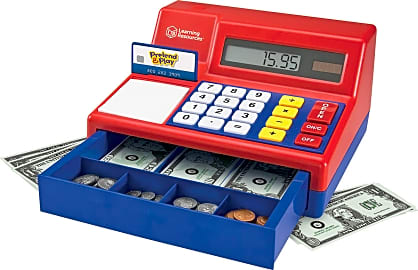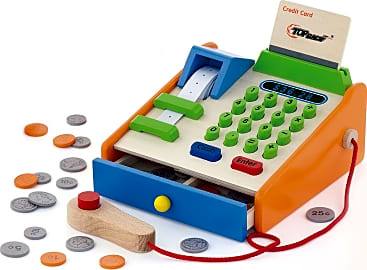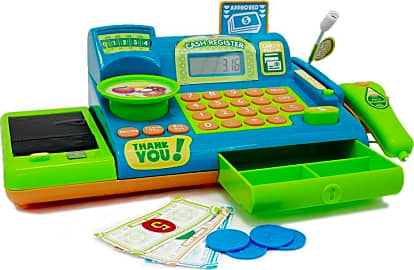The 10 Best Toy Cash Registers

This wiki has been updated 37 times since it was first published in June of 2016. Looking for a gift that can help your little one learn real-world skills? Then check out our comprehensive selection of toy cash registers. Not only do they provide a fun way for kids to re-create a shopping experience, they can also teach math, color recognition, and more. Just be careful not to allow children younger than three to play with these, due to potential choking hazards. When users buy our independently chosen editorial selections, we may earn commissions to help fund the Wiki.
Editor's Notes
November 23, 2020:
In this update, we removed the Learning Journey Shop and Learn due to a frustrating design flaw that caused coins to get stuck under the drawer. New to the list is the Joyin Smart, which has bright colors, a friendly face, and a collection of fake food that can be "scanned" either during free play or as part of one of the built-in games. Even when not playing with the register, the food itself encourages counting by having numbers etched into individual components of the pieces (for example, kids can count the eggs in a carton or the grapes in a bunch).
When choosing a toy cash register, there are a few things worth keeping in mind. One is the age of the child who will be playing with it. Units designed for younger kids, like the Fisher-Price Classic and Little Tikes Count 'n Play, come with over-sized coins that are less likely to be a choking hazard. On the other hand, older kids will probably appreciate the life-size money that comes with the Learning Resources Pretend & Play. Another factor worth considering is whether or not you're looking for electronic components. Wooden models like the Hape Checkout and Top Race 30-Piece encourage imagination, while more modern designs like the VTech Ring and Learn and LeapFrog Count Along have working parts and built-in games that help keep kids occupied and encourage learning.
March 01, 2019:
Due to increasing parental interest in wooden toys, both for their aesthetics and concerns about exposure to plastics we added the Top Race 30-piece for a second wooden register option on this list. These models lack the bells and whistles of some of the plastic choice, but instead offer a more quiet, less stimulating option that some might prefer. The V-Tech Ring and Learn was promoted to the stop spot for its wide range of features and educational value even when the child is playing alone.
Making Change: Choosing a Toy Cash Register
Many toy registers feature basic and engaging games where colors and/or shapes must be matched or fruits must be identified.
Toy cash registers have been popular with children for generations. In fact, for a time the iconic Tom Thumb toy register was one of the most popular gifts in the United States. First produced in 1945 by the Michigan-based company Western Stamping, within just a few years nearly three-quarters of a million of the simple, durable metal tills had been created. The Tom Thumb cash register was produced by the millions throughout the 1950s and 1960s, and was not only popular all across America but was sold in multiple international markets as well.
While Tom Thumb registers are now relegated to antique status, collected by discerning (and/or nostalgic) adults but infrequently seen in the hands of a child, toy registers in general remain wildly popular. And today's youth have many more options than that simple lever-operated stamped metal toy from days gone by. Modern toy tills feature everything from calculating capacity to built-in games to touch screen capabilities.
While a slight generalization, it is not inaccurate to say that there are essentially two types of toy cash register: the device intended exclusively for play that offers amusement but no real chance for educational development, and those that can actually be used to complete mathematical computations and which help teach the fundamentals of using numbers. There is no right or wrong option; one must simply consider the register's recipient in terms of age, interest, and attention span.
In fact, choosing the right child's cash register is rather simple when approached as a step-by-step process. First consider whether or not you want a unit that has actual calculating abilities (essentially in the form of a basic calculator built into the face of the unit). That stipulation will eliminate certain options, leaving you to choose a register largely based on aesthetics and binary considerations such as what sounds and flashing lights you prefer or wish to avoid.
If you are more interested in getting a young child a toy than a teaching tool, consider registers that foster independent play, as that is as critical a skill as math in the early years. Many toy registers feature basic and engaging games where colors and/or shapes must be matched or fruits must be identified. And all toy registers, regardless of their complexity level, can help foster fine motor development such as comes with handling play money, operating switches and buttons, and doing some imaginary shopping.
Ideal Toy Cash Register Accessories
A toy cash register is such an amazing gift for a child not only for its inherent qualities as noted earlier, but as it serves is the perfect jumping-off point for profound imaginative play. Children generally seek to emulate that which they regularly observe -- thus the youngster's desire to "play house" with stuffed animals, dolls, and/or parents and playmates -- and in the course of many given days a cash register is a regular fixture of an activity.
With their own till, a child can imagine their play space to be a grocery store, a pet store, a diner, or so many of the other places to which they are often exposed, albeit now in control of the situation. Encouraging this type of play is always a good move for the parent, caregiver, or the teacher at a nursery or preschool; enhancing such activities with a few more choice items is also wise.
By selecting a few familiar objects, such as pretend foods or sundries a child will easily recognize from a store (like rolls of paper towels, soaps, and so forth) you can help children navigate pantomimed exchanges, take on roles (the cashier and the customer, e.g.), and to keep the mathematics and organization that come with pretend shopping easier to manager. A toy cash register can serve as the starting point for establishing a shop full of other toys and objects with which to be played and negotiated and that can be counted, loaded onto shelves or into bags, and that can bring a sense of success and empowerment to the young mind.
Perhaps best of all, when "shopping" and completing transactions using a register, children are actively using and developing math skills under the guise of play. These activities lend the perfect opportunity for parents or educators to offer subtle but impactful guidance and input that will help a child or a group of children count, group, subtract, and more.
(As noted, many toy registers come with many accessories, so additional items might not be needed. But as play can be supplemented at no cost using emptied household containers -- cereal boxes or rinsed-out juice cartons, for example -- a unit that does not come with such items should not be thought less of.)
Learning Math Skills Through Play
The most basic math skills -- addition and subtraction -- are nonetheless conceptual and confusing when first approached by a young mind. Using tangible, physical objects to help cement these concepts in the real world makes learning to add and subtract simpler; pairing hands-on math with numerical data can help make sense of the latter. Or, in other words, "two plus one equals three" might not make much sense to a toddler, but seeing that two apples joined by one more piece of fruit creates a group of three is much easier to process.
While the adult in the room knows the ultimate goal is to learn math skills, the learners can feel that their goal is to properly complete an imaginary shopping trip.
A parent or teacher can help a youngster create one-to-one correspondence (the number "1" correlating to one object, "2" to two objects, etc.) by using the numbers on the screen of a cash register and an actual object at the same time. And using familiar objects, such as play fruits or other food objects can be much more effective than using nondescript items such as discs or blocks. And a calculator "hidden" in the form of yet another play object only furthers this success.
Adding a toy cash register into the "play" that is helping to teach basic addition and subtraction will make the activity more purpose-driven and engaging. While the adult in the room knows the ultimate goal is to learn math skills, the learners can feel that their goal is to properly complete an imaginary shopping trip.
As math skills develop, soon the inclusion of play money can add a new layer to the learning. As mastering number values requires a grasp of the conceptual rather than the tangible alone, keeping track of the value of bills can help to bridge the gap between simple counting and elevated activities like grouping, multiplication, and so forth.















